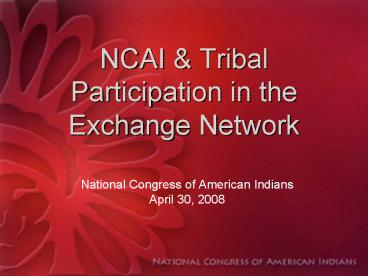NCAI - PowerPoint PPT Presentation
1 / 18
Title: NCAI
1
NCAI Tribal Participation in the Exchange
Network
- National Congress of American Indians
- April 30, 2008
2
NCAI/EN Partnership
- Cooperative Agreement signed in November 2005
- Primary objective was increasing awareness
throughout Indian Country about the EN and
thereby develop tribal capacity for environmental
data sharing and participate in the EN.
3
National Congress of American Indians
- Founded in 1944 by tribal leaders in response
to assimilation policies by the United States
4
Indian Country
5
American Indians in the United States
- 563 (and counting) federally recognized tribes
- Approximately 230 are located in Alaska
- 4.1 million people identify as American Indian or
Alaska Native - Over 70 tribal governments employee 300 or more
employees. - Tribes have jurisdiction of over 55 million acres
- Reservation land bases range in size from over 15
million acres to less than one acre.
6
Difficulties for Tribes
- Limited staff resources
- Small departments
- IT staff
- Often old infrastructure
- Dial-up internet
- Old computers
- Multiple data formats
7
Why Tribes Care
- Allows them to be in compliance
- Sec 106 grants
- Build infrastructure
- Broadband penetration rates under 10 on Indian
Reservations - Build environmental programs
- Make smarter decisions
- Get to go to fun meetings
8
Why Tribes Are Hesitant..
- Cumbersome start-up
- Steep learning curve
- Maintenance
- Network doesnt always fit into tribes
immediate needs (time, projects) - Operation costs post-grant
- Internal capacity
- Who runs the program internally?
- Tribal/Federal government relations
9
Tribal Exchange Network Participation
- To date 92 Tribal Grants (through 2007) have
been awarded (13.3M Total) - 53 tribes involved
- 28 tribes intend to use the Network to exchange
information - Eight tribes have established nodes (data
exchange hardware/software) - Several tribes are close to having working nodes
(5 in development, 16 planning)
10
Tribal Exchange Network Partners
11
NCAI EN Accomplishments
- Hosted three (3) National EN Tribal Meetings
- Coordinated tribal meeting to discuss the Draft
EN Tribal Strategy - Created webpage on NCAI site to host information
about the Network - NCAI staff began participation as member of
Network governance through the Exchange Network
Leadership Council.
12
EN Tribal Users Meetings
- First tribal-specific meetings, held on tribla
lands, to discuss the Network - Meeting 1 April 6-7, 2006 Seminole Indian
Nation, near Ft. Lauderdale, FL - Meeting 2 March 20-21, 2007, Cherokee Nation,
near Tulsa, OK - Meeting 3 April 9-10, 2008, Agua Caliente Band
of Cahuilla Indians, Palm Springs, CA
13
Tribal EN Initiatives
- Coeur dAlene Tribe, ID
- Uses
- Agricultural burning, smoke management
- Pesticides
- Purchased and set-up ArcIMS Web Server and Data
Server - Allowed data exchange within and outside of
Tribe - Exchanged data with EPA in Seattle, USGS in
Spokane - Providing metadata out to USGS Geospatial One
Stop
14
Tribal EN Initiatives (cont)
- Southern Ute Tribe
- Peer-mentoring program
- Combat contractor costs, employee turn-over
problems - Tribe-Tribe training
15
Tribal EN Initiatives (cont)
- Cherokee Tribe
- Open dump schema
- The Web Sanitation Tracking and Reporting System
(wSTARS) - Sanitation data required by regional Indian
Health Service office, and reported to Congress. - Frequent, redundant data submissions to IHS
- Detailed database of IHS sites Includes
- Solid Waste Sites
- Water Projects
- Sewer Projects
- Official Open Dumps in Indian Country Database
16
Future NCAI Work
- Tribal Baseline Assessment
- Fourth Tribal Users Meeting
- Continue to assist Network governance board
- - ENLC participation, support tribal
representation on NPRG, NTG, NOB - Network briefings and presentations at NCAI
meetings
17
The Future of Tribes and the Network
- Intertribal/Multi-tribal nodes hold promise
- Often one tribe not able to manage a node/client
- Spread resources
- Create partnerships
- Environmental data will only become more
important for tribes - GIS, land-use, water
18
Conclusion
- NCAI has achieved relative success in reaching
the proposed goals and benefits wanted from the
NCAI/EPA EN partnership. There is still much
work to be done. NCAIs efforts will lead to
better EPA/EN tribal relations and increased
Exchange Network tribal participation.































